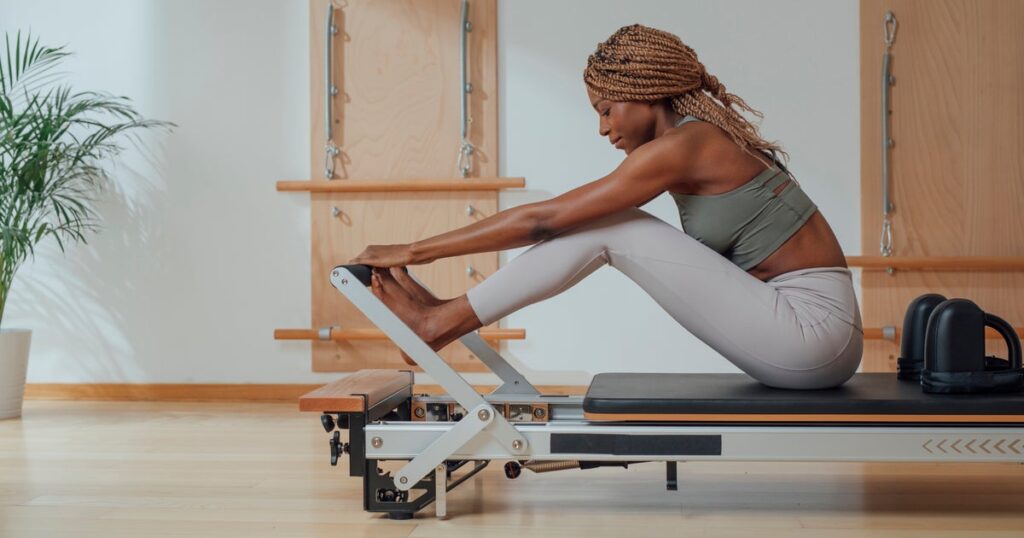Pilates is having a moment right now. There are Pilates studios opening all over, droves of fitness influencers touting its benefits and a public interest in Pilates classes — last year Pilates was the most-booked type of class on ClassPass, a fitness class booking app.
So, what exactly is this popular type of fitness?
“Pilates is a low-impact, full-body movement method focused on core strength, control, alignment and breath,” Lisa Hirsch-Solomon, the founder and CEO of The Studio (MDR) in California, told HuffPost via email.
“Pilates is an exercise methodology created by Joseph Pilates. He developed this method primarily for rehabilitation purposes, but it could also be adapted to provide a more strenuous workout,” noted Jessica Benhaim, the owner of Lumos Yoga and Barre in Philadelphia, a studio that also offers Pilates classes.
Pilates involves movements that look a little like yoga, as they also tend to be slow and controlled, but are very different from the practice. You may be familiar with Pilates movements like the single-leg stretch or the roll up.
There are multiple Pilates modalities, including reformer Pilates and mat Pilates, which are meant to be complementary to one another, Benhaim said.
This is why many Pilates studios offer comprehensive fitness programs with a chance to try all of the modalities, added Benhaim.
Two popular Pilates modalities that you’ve likely seen at gyms in your town are mat Pilates and reformer Pilates. As the name suggests, mat Pilates is done on a mat while reformer Pilates involves a reformer machine (which looks pretty intimidating, but experts say it’s really not).
Below, Pilates instructors share what to know about each modality and how you can get started:
Reformer Pilates
Reformer Pilates is a big trend right now, said Sonja Herbert, a Pilates instructor in Georgia and the founder of Black Girl Pilates, which is why you’re likely seeing gyms open up that just focus on reformers.
“And I kind of understand it in that it does introduce people to a piece of Pilates equipment versus several pieces in more of a group format, because in a private format, it’s so much more expensive for most folks,” Herbert said.
“Reformer Pilates is a workout done on a machine that uses springs for resistance,” said Hirsch-Solomon.
“It focuses on control, alignment and strength, with added challenge from the moving carriage and straps.”
“Nothing with reformer Pilates is meant to be done fast … everything is done with slow, controlled movement,” Benhaim said.
There’s also a focus on your breath during each movement, Benhaim added.
“The machine looks intimidating, but again — every exercise is focused on a controlled range of motion,” said Benhaim.
According to Hirsch-Solomon, reformer Pilates is joint-friendly and helps improve flexibility, build lean muscle and grow your body awareness.
The reformer is also made in a clinical version that is used in physical therapy as a rehabilitation tool, Benhaim said.
Kseniya Ovchinnikova via Getty Images
Mat Pilates
“Mat Pilates is specifically on the mat,” said Herbert. It tends to be equipment-less, but there are certain pieces of equipment, such as a Pilates ring, blocks or bands that can be used, Herbert added.
“It’s strictly just Pilates exercises on the floor, and I would even go so far as to say that it is exercise is sitting down and standing up, because we do have people who are not able to get to the floor or lie down … they can do Pilates in the chair,” Herbert said, “so, it’s pretty much Pilates without the use of the other Pilates equipment.”
You use your bodyweight for resistance instead of straps and springs, added Benhaim, and it tends to be the most accessible type of Pilates because you just need a mat to do it.
Both are valuable forms of Pilates.
“From an instructor standpoint, neither is better. They’re all equal. Whether it’s the mat, the reformer or any other equipment, they all have their own separate challenges,” said Herbert.
Some people prefer the mat while others prefer the reformer, Herbert added.
Both are great options, but they do have differences. The mat involves bodyweight exercise, which is a pro for some and a con for others.
“So, on the mat, it is just all you. There’s no springs, there’s no straps, there’s no ropes, there’s no foot straps, there’s no handles to help you … so that is where you find out how much your body has retained by being on the equipment,” Herbert added.
The reformer has built-in resistance and “gives you a little more to work with,” said Hirsch-Solomon.
“The machine’s springs offer resistance, making it especially great for building strength and adding a new level of challenge. Plus, it gives you better feedback on your form and alignment, which can be super helpful for injury prevention or rehab,” noted Hirsch-Solomon.
When it comes to accessibility, there are differences, though. Reformer Pilates tends to be a little more expensive too, noted Benhaim, while mat Pilates can be done anywhere with just a mat.
“The beauty of mat Pilates is its convenience — you can roll out a mat pretty much anywhere—your living room, a hotel room, the park — and still get in a solid, consistent workout,” said Hirsch-Solomon, “it is incredibly accessible.”
And both can help your overall workout regimen.
Pilates is very different from other exercise, such as high-intensity cardio or a quick-moving exercise class, which makes it a great companion to other types of workouts, said Benhaim.
“People who do strength training, running, any sort of more active movement that you’re doing, Pilates is a really great complement to it because it is going to help build your core strength,” Benhaim said.
It’s also a slower workout, which is a welcome change from so much of the fitness industry (and from the fast-paced world).
Plus, since it’s slower-paced, “you are taking the time to really stretch and work different muscles without doing something necessarily as active or as high intensity as running or cardio class or strength training,” she added.
If you want to get started, keep a few things in mind:
There is no right way to start Pilates. ”[You] can start either on the mat or on equipment. It doesn’t matter — an introduction to Pilates is an introduction to pilates,” said Herbert.
It is important, though, to make sure you are going to an accredited Pilates instructor who can properly train you, said Benhaim. As Pilates grows in popularity, so do fast-track programs to train instructors, she added — and this isn’t a good thing.
“As with any equipment-based fitness class, it’s incredibly important that instructors are properly trained,” Benhaim noted.
“People should feel comfortable asking where someone did their training and how much teaching experience they have if that information isn’t publicly available on an instructor’s bio or a studio’s website,” Benhaim said.
This is especially important for those who have an injury, are pregnant, postpartum or have other limitations.
“They should look for instructors who have completed a comprehensive training, or instructors who may be newer to teaching Pilates but have extensive teaching and fitness experience and prior fitness certifications,” added Benhaim.
This way, you’ll be able to safely try this full-body exercise without any risks to your health.
Read the full article here








